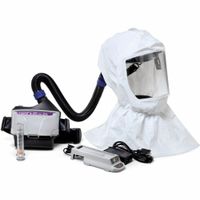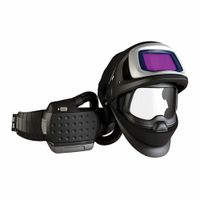Call +(254) 703 030 000 / 751 483 999 / 721 704 777
.....Read More
Frequently Asked Questions
What is a PAPR system and how does it work?
A Powered Air-Purifying Respirator (PAPR) is a type of personal protective equipment (PPE) designed to safeguard the wearer from inhaling harmful airborne contaminants. It consists of a battery-powered blower that pulls ambient air through a filter or cartridge, which removes particulates, gases, or vapors, depending on the filter type. The purified air is then delivered to the wearer’s facepiece, hood, or helmet, providing a continuous flow of clean air.
The PAPR system typically includes several key components:
1. **Blower Unit**: This is the core of the system, containing a fan powered by a rechargeable battery. It draws in air and pushes it through the filters.
2. **Filters/Cartridges**: These are selected based on the specific contaminants present in the environment. They can be particulate filters, gas/vapor cartridges, or a combination of both.
3. **Breathing Tube**: This connects the blower unit to the facepiece or hood, channeling the filtered air to the wearer.
4. **Facepiece/Hood/Helmet**: This is the part worn on the head, providing a seal to prevent unfiltered air from entering. It can be a full-face mask, a loose-fitting hood, or a helmet, depending on the level of protection required.
5. **Battery**: Powers the blower unit, ensuring a consistent flow of air. Batteries are typically rechargeable and may have indicators to show charge levels.
The PAPR system works by creating positive pressure inside the facepiece or hood, which helps prevent contaminated air from leaking in. This makes PAPRs suitable for environments with high levels of contaminants or where a high level of respiratory protection is needed. They are commonly used in healthcare, industrial, and hazardous material handling settings.
What are the components of a PAPR system?
A Powered Air-Purifying Respirator (PAPR) system consists of several key components:
1. **Blower Unit**: This is the core component that draws in ambient air and pushes it through the filter. It is powered by a battery and ensures a continuous flow of air to the user.
2. **Filter/Cartridge**: The filter removes contaminants from the air. Different filters are available for various types of hazards, such as particulates, gases, or vapors. The choice of filter depends on the specific environment and contaminants present.
3. **Breathing Tube**: This flexible tube connects the blower unit to the headgear, allowing the purified air to be delivered to the user. It must be securely attached to prevent leaks.
4. **Headgear**: This includes a hood, helmet, or facepiece that covers the user's head and face. It provides a protective barrier and ensures that the purified air is directed to the breathing zone. The headgear can vary in design, offering different levels of protection and comfort.
5. **Battery Pack**: The battery powers the blower unit. It is rechargeable and must be regularly maintained to ensure the PAPR system functions effectively. Battery life can vary based on usage and environmental conditions.
6. **Harness or Belt**: This component is used to carry the blower unit and battery pack, allowing the user to move freely. It should be adjustable for comfort and secure fit.
7. **Control System**: Some PAPR systems include a control system to adjust airflow, monitor battery life, and provide alerts for filter replacement or low battery.
Each component must be compatible and properly maintained to ensure the PAPR system provides effective respiratory protection.
How do you choose the right filter or cartridge for a PAPR?
To choose the right filter or cartridge for a Powered Air-Purifying Respirator (PAPR), consider the following factors:
1. **Contaminant Type**: Identify the specific contaminants present in the environment. Filters are designed to protect against particulates, gases, or vapors. Use particulate filters for dust, mists, and fumes, and gas/vapor cartridges for chemical hazards.
2. **Concentration Levels**: Determine the concentration levels of the contaminants. This helps in selecting the appropriate filter efficiency and type. Higher concentrations may require more efficient filters.
3. **Filter Efficiency**: Choose filters based on their efficiency ratings. For particulates, NIOSH ratings like N95, P95, or HE (High Efficiency) indicate the level of protection. HE filters are typically used in PAPRs.
4. **Chemical Compatibility**: For gas and vapor protection, ensure the cartridge is compatible with the specific chemicals. Cartridges are often color-coded and labeled for specific gases or vapors, such as organic vapors, acid gases, or ammonia.
5. **Work Environment**: Consider the work environment conditions, such as temperature, humidity, and presence of multiple contaminants, which may affect filter performance.
6. **Regulatory Compliance**: Ensure the selected filters and cartridges comply with relevant safety standards and regulations, such as those set by OSHA or NIOSH.
7. **PAPR Compatibility**: Verify that the filter or cartridge is compatible with the specific PAPR model being used. Manufacturers provide compatibility charts or guidelines.
8. **Duration of Use**: Consider the expected duration of exposure and the filter's service life. Some filters have limited use times and need regular replacement.
9. **User Comfort**: Ensure the filter does not add excessive weight or discomfort, which could affect user compliance and safety.
10. **Cost and Availability**: Evaluate the cost-effectiveness and availability of the filters or cartridges, ensuring a reliable supply for ongoing protection.
What are the differences between loose-fitting and tight-fitting PAPR systems?
Loose-fitting PAPR (Powered Air-Purifying Respirator) systems and tight-fitting PAPR systems differ primarily in their design, fit, and application:
1. **Fit and Seal**:
- **Loose-fitting PAPR**: These systems do not require a tight seal against the face. They typically include hoods or helmets that cover the head and sometimes the shoulders, allowing for a more comfortable fit without the need for a face seal.
- **Tight-fitting PAPR**: These require a secure seal against the face, similar to traditional respirators. They include full-face masks or half masks that must fit snugly to ensure no contaminated air bypasses the filter.
2. **Comfort and Usability**:
- **Loose-fitting PAPR**: Generally more comfortable for extended wear, as they do not exert pressure on the face. They are suitable for users with facial hair or those who cannot achieve a proper seal with tight-fitting masks.
- **Tight-fitting PAPR**: May be less comfortable over long periods due to the pressure required to maintain a seal. Users must be clean-shaven where the mask seals to the face.
3. **Protection Level**:
- **Loose-fitting PAPR**: Offers a lower Assigned Protection Factor (APF) compared to tight-fitting systems but still provides adequate protection for many industrial applications.
- **Tight-fitting PAPR**: Provides a higher APF, making them suitable for environments with higher concentrations of airborne contaminants.
4. **Applications**:
- **Loose-fitting PAPR**: Ideal for environments where comfort and ease of communication are prioritized, such as healthcare settings.
- **Tight-fitting PAPR**: Used in more hazardous environments where maximum protection is necessary, such as chemical handling or asbestos removal.
5. **Breathing Resistance**:
- Both systems use a powered fan to assist breathing, reducing breathing resistance compared to non-powered respirators. However, the experience may vary based on the fit and design.
Do PAPR systems require fit testing?
Yes, Powered Air-Purifying Respirators (PAPRs) generally require fit testing, but it depends on the type of PAPR and the specific regulations or guidelines being followed. Fit testing is crucial for ensuring that the respirator provides the intended level of protection by forming a proper seal with the user's face.
For tight-fitting PAPRs, which include half-mask and full-facepiece respirators, fit testing is required. These types of PAPRs rely on a tight seal between the respirator and the user's face to prevent contaminants from entering. Fit testing ensures that the respirator fits the user correctly and that there are no leaks.
For loose-fitting PAPRs, such as those with hoods or helmets, fit testing is generally not required. These respirators do not rely on a tight seal with the face, as they use a continuous flow of filtered air to provide protection. However, it is still important to ensure that the hood or helmet fits properly and that the user is trained in its correct use.
Regulatory bodies like the Occupational Safety and Health Administration (OSHA) in the United States mandate fit testing for tight-fitting respirators as part of their respiratory protection standards. Employers are responsible for ensuring that fit testing is conducted before the initial use of the respirator, whenever a different respirator facepiece is used, and at least annually thereafter.
In summary, while fit testing is essential for tight-fitting PAPRs, it is not required for loose-fitting models. However, proper training and fitting are crucial for all types of PAPRs to ensure effective protection.
How long do PAPR batteries typically last?
PAPR (Powered Air-Purifying Respirator) batteries typically last between 4 to 8 hours on a single charge, depending on several factors such as the type of battery, the model of the PAPR, the speed setting, and the environmental conditions in which it is used. Some high-capacity batteries may last up to 12 hours. Rechargeable lithium-ion batteries are commonly used in PAPRs due to their efficiency and longer life compared to other types like nickel-cadmium or nickel-metal hydride.
The duration can be affected by the airflow setting; higher airflow rates generally consume more power, reducing battery life. Additionally, the age and condition of the battery play a significant role; older batteries or those that have been frequently charged and discharged may not hold a charge as effectively, leading to shorter operational times.
Environmental factors such as temperature can also impact battery performance. Extreme cold can reduce battery efficiency, while high temperatures can lead to overheating and reduced lifespan. Regular maintenance, including proper charging practices and storage, can help maximize battery life.
Manufacturers often provide specific guidelines on charging cycles and storage conditions to ensure optimal performance and longevity. It's important to follow these guidelines and replace batteries as recommended to ensure the PAPR functions effectively, especially in critical environments where consistent respiratory protection is necessary.
What are the maintenance and cleaning requirements for PAPR systems?
Maintenance and cleaning of Powered Air-Purifying Respirators (PAPR) are crucial for ensuring their effectiveness and longevity. Here are the key requirements:
1. **Daily Inspection**: Before each use, inspect the PAPR for any signs of damage, wear, or malfunction. Check the battery charge, airflow, and the condition of the facepiece, headgear, and breathing tube.
2. **Cleaning**: After each use, clean the PAPR components. Disassemble the facepiece, headgear, and breathing tube. Use mild soap and warm water to clean these parts, ensuring all contaminants are removed. Rinse thoroughly and allow to air dry. Avoid using harsh chemicals or solvents that could damage the materials.
3. **Filter Replacement**: Regularly check and replace filters according to the manufacturer's guidelines or when they become clogged or damaged. The frequency of replacement depends on the environment and usage.
4. **Battery Maintenance**: Recharge batteries after each use. Follow the manufacturer's instructions for charging and storage to maximize battery life. Replace batteries as needed.
5. **Component Inspection**: Regularly inspect all components for cracks, tears, or other damage. Pay special attention to seals and gaskets, as they are critical for maintaining a proper fit and seal.
6. **Storage**: Store the PAPR in a clean, dry area away from direct sunlight and extreme temperatures. Ensure it is protected from dust and contaminants.
7. **Periodic Testing**: Conduct periodic performance tests to ensure the PAPR is functioning correctly. This may include checking airflow rates and battery performance.
8. **Documentation**: Maintain records of inspections, maintenance, and repairs. This helps track the condition of the PAPR and ensures compliance with safety regulations.
Following these maintenance and cleaning protocols will help ensure the PAPR system remains effective and safe for use.




